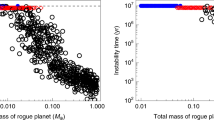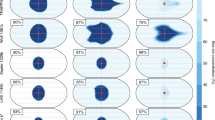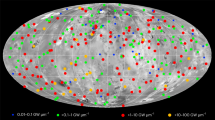Abstract
Low-mass M stars are plentiful in the Universe and often host small, rocky planets detectable with current instrumentation. These stars host magnetic fields, some of which have been observed to exceed a few hundred gauss. Recently, seven small planets have been discovered orbiting the ultra-cool M dwarf TRAPPIST-1, which has an observed magnetic field of 600 G. We suggest electromagnetic induction heating as an energy source inside these planets. If the stellar rotation and magnetic dipole axes are inclined with respect to each other, induction heating can melt the upper mantle and enormously increase volcanic activity, sometimes producing a magma ocean below the planetary surface. We show that induction heating leads the four innermost TRAPPIST-1 planets, one of which is in the habitable zone, either to evolve towards a molten mantle planet, or to experience increased outgassing and volcanic activity, while the three outermost planets remain mostly unaffected.
This is a preview of subscription content, access via your institution
Access options
Access Nature and 54 other Nature Portfolio journals
Get Nature+, our best-value online-access subscription
$29.99 / 30 days
cancel any time
Subscribe to this journal
Receive 12 digital issues and online access to articles
$119.00 per year
only $9.92 per issue
Buy this article
- Purchase on Springer Link
- Instant access to full article PDF
Prices may be subject to local taxes which are calculated during checkout





Similar content being viewed by others
References
Rudnev, V. Handbook of Induction Heating (Manufacturing, Engineering and Materials Processing). (Marcel Dekker, New York, 2003).
Morin, J. et al. Large-scale magnetic topologies of late M dwarfs.Mon Not. R Astron. Soc. 407, 2269–2286 (2010).
West, A. A. et al. Constraining the age-activity relation for cool stars: the sloan digital sky Survey data release 5 low-mass star spectroscopic sample. Astron. J. 135, 785–795 (2008).
Laine, R. O. & Lin, D. N. C. Interaction of close-in planets with the magnetosphere of their host stars. II. Super-Earths as unipolar inductors and their orbital evolution. Astrophys. J. 745, 2 (2012).
Goldreich, P. & Lynden-Bell, D. Io, a Jovian unipolar inductor. Astrophys. J. 156, 59–78 (1969).
Parkinson, W. D. Introduction to Geomagnetism (Scottish Academic Press, Edinburgh, 1983).
Gillon, M. et al. Temperate Earth-sized planets transiting a nearby ultracool dwarf star. Nature 533, 221–224 (2016).
Gillon, M. et al. Seven temperate terrestrial planets around the nearby ultracool dwarf star TRAPPIST-1. Nature 542, 456–460 (2017).
Luger, R. et al. A seven-planet resonant chain in TRAPPIST-1. Nat. Astron. 1, 0129 (2017).
Burgasser, A. J. & Mamajek, E. E. On the age of the TRAPPIST-1 system. Astrophys. J. 845, 110 (2017).
Johnstone, C. P., Güdel, M., Brott, I. & Lüftinger, T. Stellar winds on the main-sequence. II. The evolution of rotation and winds. Astron. Astrophys. 577, A28 (2015).
Irwin, J. et al. On the angular momentum evolution of fully convective stars: rotation periods for field M-dwarfs from the MEarth transit survey. Astrophys. J. 727, 56 (2011).
Reiners, A. & Basri, G. A volume-limited sample of 63 M7–M9.5 dwarfs. II. Activity, magnetism, and the fade of the rotation-dominated dynamo. Astrophys. J. 710, 924–935 (2010).
Xu, Y., Shankland, T. J. & Poe, B. T. Laboratory-based electrical conductivity in the Earth’s mantle. J. Geophys. Res. 105, 27 (2000).
Yoshino, T., Manthilake, G., Matsuzaki, T. & Katsura, T. Dry mantle transition zone inferred from the conductivity of wadsleyite and ringwoodite. Nature 451, 326–329 (2008).
Yoshino, T. & Katsura, T. Electrical conductivity of mantle minerals: role of water in conductivity anomalies. Annu. Rev. Earth. Planet. Sci. 41,605–628 (2013).
Noack, L., Rivoldini, A. & Van Hoolst, T. Modeling the evolution of terrestrial and water-rich planets and moons. Int. J. Adv. Syst. Meas. 9, 66–76 (2016).
Pearson, D. G. et al. Hydrous mantle transition zone indicated by ringwoodite included within diamond. Nature 507, 221–2244 (2014).
Noack, L., Rivoldini, A. & Van Hoolst, T. Volcanism and outgassing of stagnant-lid planets: implications for the habitable zone. Phys. Earth Planet. Inter. 269, 40–57 (2017).
Hirschmann, M. M. Mantle solidus: experimental constraints and the effects of peridotite composition. Geochem. Geophys. Geosyst. 1,2000GC000070 (2000).
Ohtani, E., Nagata, Y., Suzuki, A. & Kato, T. Melting relations of peridotite and the density crossover in planetary mantles. Chem. Geol. 120,207–221 (1995).
Reese, C. C., Solomatov, V. S. & Moresi, L. Heat transport efIiciency for stagnant lid convection with dislocation viscosity: application to Mars and Venus. J. Geophys. Res. 103, 13643–13657 (1998).
Crisp, J. Rates of magma emplacement and volcanic output. J. Volcanol. Geotherm. Res. 20, 177–211 (1984).
Ni, H. & Keppler, H. Carbon in silicate melts. Rev. Mineral. Geochem. 75, 251–287 (2013).
Yoshino, T., Matsuzaki, T., Yamashita, S. & Katsura, T. Hydrous olivine unable to account for conductivity anomaly at the top of the asthenosphere. Nature 443, 973–976 (2006).
Gaillard, F. & Iacono Marziano, G. Electrical conductivity of magma in the course of crystallization controlled by their residual liquid composition. J. Geophys. Res. 110, B06204 (2005).
Maumus, J., Bagdassarov, N. & Schmeling, H. Electrical conductivity and partial melting of mafic rocks under pressure. Geochim. Cosmochim. Acta. 69, 4703–4718 (2005).
Yoshino, T., Laumonier, M., McIsaac, E. & Katsura, T. Electrical conductivity of basaltic and carbonatite melt-bearing peridotites at high pressures: implications for melt distribution and melt fraction in the upper mantle. Earth. Planet. Sci. Lett. 295, 593–602 (2010).
Beuchert, J. B. & Schmeling, H. A melting model for the lowermost mantle using Clapeyron slopes derived from experimental data: consequences for the thickness of ultralow velocity zones (ULVZs). Geochem. Geophys. Geosyst. 14, 197–208 (2013).
Breuer, D. & Moore, B. Dynamics and thermal history of the terrestrial planets, the Moon, and Io. Physics of Terrestrial Planets and Moons 10, 255–305 (2015).
Stein, C., Lowman, J. P. & Hansen, U. The influence of mantle internal heating on lithospheric mobility: implications for super-Earths. Earth. Planet. Sci. Lett. 361, 448–459 (2013).
Stamenković, V. & Breuer, D. The tectonic mode of rocky planets: Part 1–driving factors, models & parameters. Icarus 234, 174–193 (2014).
Schubert, G., Solomatov, S., Tackley, P. J. & Turcotte, D. L. in Venus II: Geology, Geophysics, Atmosphere, and Solar Wind Environment (eds. Bougher, S. W. et al.) 1245–1288 (Univ. Arizona Press, Tucson, 1997).
Steinbach, V., Yuen, D. A. & Zhao, W. L. Instabilities from phase transitions and the timescales of mantle thermal evolution. Geophys. Res. Lett. 20, 1119–1122 (1993).
Noack, L., Breuer, D. & Spohn, T. Coupling the atmosphere with interior dynamics: Implications for the resurfacing of Venus. Icarus 217,484–498 (2012).
Moore, W. B. & Webb, A. A. G. Heat-pipe Earth. Nature 501, 501–505 (2013).
Glassmeier, K.-H. et al. Electromagnetic induction effects and dynamo action in the Hermean system. Space. Sci. Rev. 132, 511–527 (2007).
Yanagisawa, M. Can electromagnetic induction current heat Io’s interior effectively? Lunar Planet. Sci. Conf. 11, 1288–1290 (1980).
Peale, S. J., Cassen, P. & Reynolds, R. T. Melting of Io by tidal dissipation. Science 203, 892–894 (1979).
Anglada-Escudé, G. et al. A terrestrial planet candidate in a temperate orbit around Proxima Centauri. Nature 536, 437–440 (2016).
Reiners, A. & Basri, G. The moderate magnetic field of the flare star Proxima Centauri. Astron. Astrophys. 489, L45–L48 (2008).
Campbell, I. H., Czamanske, G. K., Fedorenko, V. A., Hill, R. I. & Stepanov, V. synchronism of the siberian traps and the permian-triassic boundary. Science 258, 1760–1763 (1992).
Renne, P. R. & Basu, A. R. Rapid eruption of the siberian traps flood basalts at the permo-triassic boundary. Science 253, 176–179 (1991).
Black, B. A., Elkins-Tanton, L. T., Rowe, M. C. & Peate, I. U. Magnitude and consequences of volatile release from the Siberian Traps. Earth. Planet. Sci. Lett. 317, 363–373 (2012).
Black, B. A., Lamarque, J., Shields, C. A., Elkins-Tanton, L. T. & Kiehl, J. T. Acid rain and ozone depletion from pulsed Siberian Traps magmatism. Geology 42, 67–70 (2013).
McEwen, A. S. et al. High-temperature silicate volcanism on Jupiter’s moon Io. Science 281, 87 (1998).
Alberti, T., Carbone, V., Lepreti, F. & Vecchio, A. Comparative climates of TRAPPIST-1 planetary system: results from a simple climate–vegetation model. Astrophys. J. 844, 19 (2017).
Wolf, E. T. Assessing the habitability of the TRAPPIST-1 system using a 3D climate model. Astrophys. J. 839, L1 (2017).
Ferré, E. C. et al. Eight good reasons why the uppermost mantle could be magnetic. Tectonophysics 624, 3–14 (2014).
Belley, F. et al. The magnetic properties of natural and synthetic (Fe x , Mg1–x )2SiO4 olivines. Earth Planet. Sci. Lett. 284, 516–526 (2009).
Nagata, T., Yukutake, T. & Uyeda, S. On magnetic susceptibility of olivines.J. Geomagn. Geoelectr. 9, 51–56 (1957).
Srivastava, S. P. Theory of the magnetotelluric method for a spherical conductor. Geophys. J. 11, 373–387 (1966).
Winn, J. N. & Fabrycky, D. C. The occurrence and architecture of exoplanetary systems. Annu. Rev. Astron. Astrophys. 53, 409–447 (2015).
Lang, P., Jardine, M., Donati, J.-F., Morin, J. & Vidotto, A. Coronal structure of low-mass stars. Mon. Not. R. Astron. Soc. 424, 1077–1087 (2012).
Altschuler, M. D. & Newkirk, G. Magnetic fields and the structure of the solar corona. I: methods of calculating coronal fields. Solar. Phys. 9, 131–149 (1969).
Mackay, D. H., Priest, E. R. & Lockwood, M. The evolution of the Sun’s open magnetic flux—II. Full solar cycle simulations. Solar. Phys. 209, 287–309 (2002).
Jardine, M., Collier Cameron, A. & Donati, J.-F. The global magnetic topology of AB Doradus. Mon. Not. R. Astron. Soc. 333, 339–346 (2002).
Gregory, S. G. & Donati, J.-F. Analytic and numerical models of the 3D multipolar magnetospheres of pre-main sequence stars. Astron. Nachr. 332, 1027 (2011).
Johnstone, C. P. Magnetic Fields and X-ray Emission in Pre-Main Sequence Stars. PhD thesis, Univ. St Andrews (2012).
Karato, S. & Wu, P. Rheology of the upper mantle: a synthesis. Science 260, 771–778 (1993).
Lammer, H. Origin and Evolution of Planetary Atmospheres(Springer, Heidelberg, 2013).
Terada, N. et al. Atmosphere and water loss from early Mars under extreme solar wind and extreme ultraviolet conditions. Astrobiology 9, 55–70 (2009).
Paschmann, G., Haaland, S. & Treumann, R. Auroral plasma physics.Space Sci. Rev. 103, 44 (2002).
Wang, S., Wu, D.-H., Barclay, T. & Laughlin, G. P. Updated masses for the TRAPPIST-1 planets. Preprint at https://arxiv.org/abs/1704.04290 (2017).
Acknowledgements
We acknowledge support by the Austrian Fonds zur Förderung der Wissenschaftlichen Forschung Nationales Forschungs Netzwerk (FWF NFN) project S116-N16 and the subprojects S11607-N16, S11604-N16 and S11606-N16. L.N. was funded by the Interuniversity Attraction Poles Programme initiated by the Belgian Science Policy Office through the Planet Topers alliance. L.N. and M.G. acknowledge support of the COST Action TD 1308. P.O. acknowledges FWF project P27256-N27. V.V.Z. acknowledges RSF project 16-12-10528. The authors acknowledge ISSI for the support of the ISSI team “The early evolution of the atmospheres of Earth, Venus, and Mars”. M.L.K. also acknowledges the FWF projects I2939-N27, P25587-N27, P25640-N27, Leverhulme Trust grant IN-2014-016 and grant no. 16-52-14006 of the Russian Foundation for Basic Research.
Author information
Authors and Affiliations
Contributions
K.G.K. calculated the induction heating. L.N. modelled the mantle effects. C.P.J. calculated stellar magnetic fields at a given orbital distance. V.V.Z. helped to derive the equations. L.F. suggested that induction heating could be substantial. H.L. provided knowledge on the habitability of exoplanets. M.L.K. checked the influence of the ionosphere. P.O. helped to write the paper. M.G. contributed expertise in exoplanetary research. All authors contributed to the text.
Corresponding author
Ethics declarations
Competing interests
The authors declare no competing financial interests.
Additional information
Publisher’s note: Springer Nature remains neutral with regard to jurisdictional claims in published maps and institutional affiliations.
Rights and permissions
About this article
Cite this article
Kislyakova, K.G., Noack, L., Johnstone, C.P. et al. Magma oceans and enhanced volcanism on TRAPPIST-1 planets due to induction heating. Nat Astron 1, 878–885 (2017). https://doi.org/10.1038/s41550-017-0284-0
Received:
Accepted:
Published:
Issue Date:
DOI: https://doi.org/10.1038/s41550-017-0284-0
This article is cited by
-
Unravelling the Electrical Conductivity of Earth and Planets
Surveys in Geophysics (2024)
-
Magma Ocean, Water, and the Early Atmosphere of Venus
Space Science Reviews (2023)
-
Synergies Between Venus & Exoplanetary Observations
Space Science Reviews (2023)
-
Disentangling atmospheric compositions of K2-18 b with next generation facilities
Experimental Astronomy (2022)
-
The Exosphere as a Boundary: Origin and Evolution of Airless Bodies in the Inner Solar System and Beyond Including Planets with Silicate Atmospheres
Space Science Reviews (2022)



